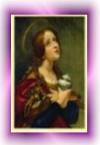The duke felt Rupert could help revive Christianity in Bavaria. The people had become lukewarm, and many had fallen victim to the heresy of Arianism. Theodo II sent many messages to Rupert imploring him to come to Bavaria and finally Rupert agreed.
When Rupert arrived he was greeted with celebrations in his honor planned by Theodo. Rupert went about attending to his mission immediately. He traveled through the territory of the Danube to the borders of Lower Pannonia and Lorch. He later traveled to the shores of Wallersee. He had a church erected in honor of St. Peter on the shores of the Wallersee. Rupert later requested that the duke give him the territory of Juvavum to build a monastery and an episcopal see. The duke bequeathed two square miles of this territory, (which is now Salzburg) to Rupert.
In the area where St. Severin and his companions were martyred, Rupert erected the first church in Salzburg. It was named the Church of St. Peter. On the outskirts of town, in a high area, he established a convent of nuns which, like the monastery, he placed under the protection and rule of St. Benedict. He made his niece Erindruda abbess over the Benedictine Convent of Nonnberg and he and his companions formed the first congregation of the Benedictine Monastery of St. Peter at Salzburg which is there today.
Rupert lived for the next several years in this monastery and died there, according to some accounts, on Easter Sunday, March 27, 718.
Saint Rupert is also responsible for establishing the salt-mining industry in the city from which it is named, Salzburg. Because of his connection with this, he is often portrayed in Christian art holding a container of salt.

